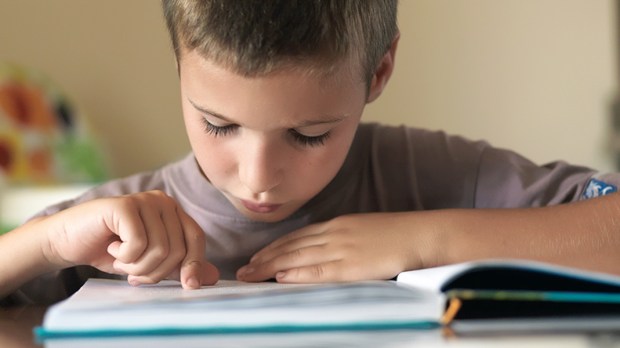Lenten Campaign 2025
This content is free of charge, as are all our articles.
Support us with a donation that is tax-deductible and enable us to continue to reach millions of readers.
My son Lincoln is learning to read. He brings home these books with simple sentences and pictures, and when he struggles to sound out a word he looks at the picture for a clue.
I don’t love the pictures. Usually what happens is that he looks at the picture and blurts out the first thing that comes to his mind, regardless of the letters that he had been previously sounding out. For example, yesterday he was reading a book about blocks and came to the word “building.”
“B-u—eye—uuu—” he struggled for a moment, flummoxed by the dipthong. His eyes darted over to the picture and he shouted triumphantly, “tower!” before attempting to turn the page.
“Linc, wait a minute,” I said as I turned the page back. “Look at the word. What sound does it start with?” He started to say “b” then switched to “t,” his eyes darting again back to the picture. I covered the picture with my hand. “Lincoln, sound the word out instead of looking at the picture.”
When the picture was no longer available to him, he finally struggled through the task of sounding out the difficult word. And every time he came to that word again, he would glance at the picture and say “tower” instead of sounding the word out. I finally began covering the picture as soon as he turned the page. Only then did he start blending the sounds reliably each time he came across the word.
I was in college before I realized that many people don’t learn to blend sounds. I was shocked at the number of my classmates — at an elite, private university — who literally could not sound words out. When reading aloud they would often guess, attempting to decipher the sound of the word based on the letters present, but it was abundantly clear that their guesses were just that.
I once asked a good friend how, if she had never learned to blend sounds and decode words, she had learned to read at all?
“We learned to read by memorizing words,” she said. “I can’t read words I’ve never seen because I don’t know them.”
My friend, like millions of other American children, was failed by our educational system. The Atlantic recently laid out the long history of the “reading wars,” concluding with the sobering truth that despite clear scientific evidence supporting it, many American children still aren’t being taught how to read:
In the early 1950s, Rudolf Flesch wrote a bestseller called Why Johnny Can’t Read, in which he blasted the American education system for failing to teach phonics. Students were expected to learn to read by memorizing words, using simple books like the Dick-and-Jane readers. Confronted with words they hadn’t memorized — like kid — they would hit a wall.
Flesch’s message resonated with parents, but educators generally dismissed it. Eventually they abandoned the Dick-and-Jane books, but they continued to insist that teaching phonics was boring and unnecessary. Surround children with good literature and encourage them to guess at words from context, teachers said, and they would naturally pick up the ability to decode, the way babies pick up the ability to speak.
Scientists
have disagreed. As many as half of all children won’t learn to read unless they get systematic instruction in what are called foundational reading skills, including phonics, according to reading expert Phyllis Bertin. And even those who manage to learn to read without that kind of instruction would benefit from it.
I had been drilled ad nauseam in phonics in elementary school, so it never occurred to me that there was another way to learn to read. And if it bothered me as a college student that my friends had never actually been taught how to read, it makes me crazy as an adult. Memorizing words isn’t reading — and knowing how to read is vital for a child’s future, no matter what field they enter.
So far, I have absolutely loved Lincoln’s kindergarten teacher and curriculum. Decoding and blending sounds is a clear priority, as the kids have now moved on to reading “nonsense” words in order to reinforce the skill of sound blending rather than sight memorization. The pictures in the book are an unfortunate reality of most kindergarten material, though, and they serve as a reminder that we still haven’t let go of the idea that the human brain is like a computer, needing only to be fed the right information in order to spit it back out later on.
The human brain is not a machine. We don’t learn to read by memorizing words in the same way we could never learn to add or subtract by memorizing numbers. Our brains have to learn how a process works, make the synaptic connections, then fine-tune that process until it becomes as automatic as breathing or sneezing. Our brains literally change when we learn to read — and it’s a different change than the one that occurs when we memorize a word. It’s a change that takes time and effort. Our kids have to struggle through it, and that can be hard for parents and teachers to watch.
I know it’s hard to watch them struggle through blending sounds. I hate that part of learning to read — but that’s the most important part. They have to be allowed to struggle in order to succeed. So the next time your kid comes home with a picture-book easy reader, do them a favor and cover up those pictures. They’ll thank you for it later.
Read more:
Learning to Read the Bible the Way Jesus Did

